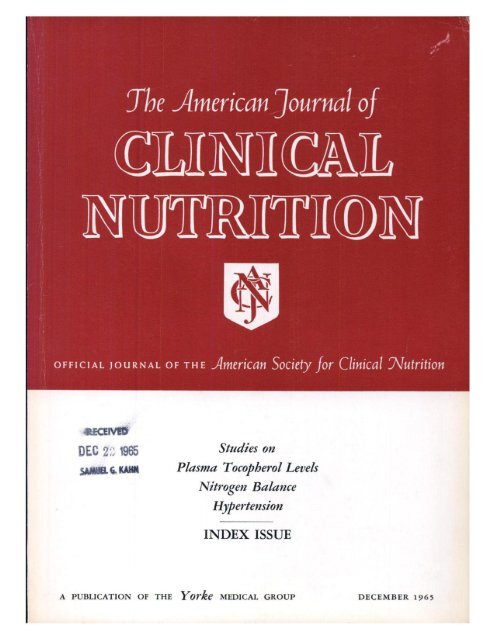Dietary polyphenols and risk of breast cancer in a predominantly low-income population: a prospective analysis in the Southern Community Cohort Study (SCCS)
IF 6.5
1区 医学
Q1 NUTRITION & DIETETICS
引用次数: 0
Abstract
Background
Few studies have examined the associations of specific dietary polyphenols with breast cancer (BC) risks or among non-Hispanic Black (NHB) female individuals in the United States.
Objectives
We aim to evaluate the associations between total and subclasses of polyphenol intake and BC risk, stratified by body mass index (BMI), estrogen receptor (ER)/progesterone receptor (PR) status, menopausal status, and racial and ethnic subgroups.
Methods
The study included 42,260 female participants from the Southern Community Cohort Study, a large prospective cohort of predominantly low-income NHB Americans. The dietary polyphenol components were assessed using a validated culturally sensitive 89-item food frequency questionnaire designed specifically for nutrient intakes in the South. Cox proportional hazards model was used to assess the associations after adjustment for confounders including sociodemographic and lifestyle factors.
Results
Intakes of total polyphenols were higher in non-Hispanic white (1122 ± 727 mg/d) than in NHB female individuals (535±349 mg/d). Intakes of total polyphenol, particularly phenolic acids, were associated with reduced risk of BC incidence among female individuals with the ER+ and PR+ BC type comparing the highest to the lowest quintile [hazard ratio (HR) 0.69; 95% confidence interval (CI): 0.51, 0.94; P-trend = 0.003; HR 0.70; 95% CI: 0.53, 0.95; P-trend = 0.005, respectively]. Phenolic acid was inversely related to BC among postmenopausal female individuals (HR 0.76; 95% CI: 0.59, 0.97; P-trend = 0.02) and female individuals with a BMI ≥ 25 kg/m2 (HR 0.77; 95% CI: 0.60, 0.98; P-trend = 0.01) comparing the highest to the lowest quintile. Intakes of tyrosols were associated with increased risk of BC among NHB female individuals (HR 1.34; 95% CI: 1.03, 1.73; P-trend = 0.01) and female individuals with a BMI ≥ 25 kg/m2 (HR 1.31; 95% CI: 1.04, 1.65; P-trend = 0.004).
Conclusions
In this predominantly low-income United States population, intakes of total polyphenol and phenolic acids were associated with reduced risk of BC among those with ER+ and PR+ BC type, postmenopausal, and female individuals with overweight/obesity.
饮食多酚与主要低收入人群乳腺癌风险:南方社区队列研究(SCCS)的前瞻性分析。
背景:很少有研究探讨特定膳食多酚与乳腺癌(BC)风险或美国非西班牙裔黑人(NHB)女性乳腺癌风险之间的关系:我们旨在评估多酚总摄入量和亚类摄入量与乳腺癌风险之间的关系,并根据体重指数(BMI)、雌激素受体(ER)/孕激素受体(PR)状态、绝经状态以及种族和民族亚群进行分层:该研究包括来自南方社区队列研究(SCCS)的 42,260 名女性参与者,这是一个主要由低收入的美国 NHB 组成的大型前瞻性队列。膳食中的多酚成分是通过专门为南方营养素摄入量设计的、经过验证的、具有文化敏感性的 89 项食物频率问卷(FFQ)进行评估的。在对包括社会人口学和生活方式因素在内的混杂因素进行调整后,采用 Cox 比例危险模型对相关性进行评估:结果:非西班牙裔白人(NHW)的总多酚摄入量(1122±727 毫克/天)高于 NHB 女性(535±349 毫克/天)。在ER+和PR+ BC型女性中,摄入总多酚,尤其是酚酸,与ER+和PR+ BC型女性中最高和最低五分位数相比,与 BC发病风险降低有关(HR,0.69;95%CI,0.51-0.94;P-trend=0.003;HR,0.70;95%CI,0.53-0.95;P-trend=0.005)。绝经后女性(HR,0.76;95%CI,0.59-0.97;P-trend=0.02)和体重指数(BMI)≥25 kg/m2的女性(HR,0.77;95%CI,0.60-0.98;P-trend=0.01)中,酚酸与萃取率成反比。酪醇摄入量与NHB女性(HR,1.34;95%CI,1.03-1.73;P-trend=0.01)和BMI≥25 kg/m2女性(HR,1.31;95%CI,1.04-1.65;P-trend=0.004)罹患BC的风险增加有关:结论:在这一以低收入为主的美国人群中,总多酚和酚酸的摄入量与ER+和PR+ BC型、绝经后和超重/肥胖女性的BC风险降低有关。
本文章由计算机程序翻译,如有差异,请以英文原文为准。
求助全文
约1分钟内获得全文
求助全文
来源期刊
CiteScore
12.40
自引率
4.20%
发文量
332
审稿时长
38 days
期刊介绍:
American Journal of Clinical Nutrition is recognized as the most highly rated peer-reviewed, primary research journal in nutrition and dietetics.It focuses on publishing the latest research on various topics in nutrition, including but not limited to obesity, vitamins and minerals, nutrition and disease, and energy metabolism.
Purpose:
The purpose of AJCN is to:
Publish original research studies relevant to human and clinical nutrition.
Consider well-controlled clinical studies describing scientific mechanisms, efficacy, and safety of dietary interventions in the context of disease prevention or health benefits.
Encourage public health and epidemiologic studies relevant to human nutrition.
Promote innovative investigations of nutritional questions employing epigenetic, genomic, proteomic, and metabolomic approaches.
Include solicited editorials, book reviews, solicited or unsolicited review articles, invited controversy position papers, and letters to the Editor related to prior AJCN articles.
Peer Review Process:
All submitted material with scientific content undergoes peer review by the Editors or their designees before acceptance for publication.

 求助内容:
求助内容: 应助结果提醒方式:
应助结果提醒方式:


